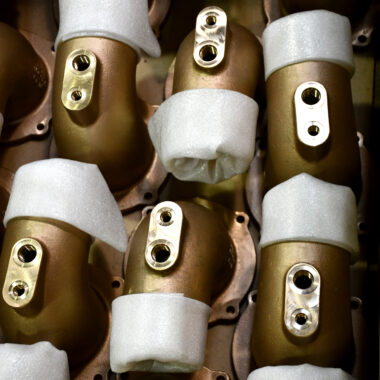The Ultimate Overview to Aluminum Casting: Professional Insights and Ideal Practices
The Ultimate Overview to Aluminum Casting: Professional Insights and Ideal Practices
Blog Article
Study the Globe of Aluminum Casting: Recognizing the Various Techniques
Light weight aluminum spreading is an essential process in the production market, with different techniques employed to create detailed and exact parts. Understanding the various strategies made use of in light weight aluminum casting can provide beneficial understandings into the abilities and restrictions of each approach. From the typical sand casting method to the sophisticated die spreading process, each method uses distinct benefits relying on the needs of the job. Exploring these varied methods can use a comprehensive sight of the possibilities within the globe of aluminum spreading and how each technique adds to shaping the modern-day manufacturing landscape.
Sand Casting Method
Sand casting, a widely-used method in aluminum spreading procedures, entails creating molds made of compacted sand for putting liquified steel. When the mold is prepared, it is securely placed in a flask and molten aluminum is put right into the dental caries.
After the steel has actually cooled down and solidified, the sand mold is broken away to reveal the aluminum spreading. Sand spreading enables for the production of complex forms and huge components that may be expensive or challenging to produce making use of various other techniques. It is also a lasting method as the sand can be recycled and used numerous times, minimizing waste in the casting process.
Permanent Mold And Mildew Method

One considerable benefit of the Permanent Mold Strategy is the boosted dimensional precision it uses. The metal mold and mildew permits for tighter resistances and better information in the last light weight aluminum spreadings contrasted to sand spreading techniques. This precision makes it a recommended option for applications where tight dimensional control is critical, such as in the auto and aerospace sectors.

Die Casting Refine

Financial Investment Casting Technique
Utilizing a precision casting method, Investment Casting Technique entails developing complex light weight aluminum elements by putting liquified metal right into a ceramic mold. This process, additionally known as lost-wax casting, begins with the creation of a wax pattern of the wanted about his component (aluminum casting).
The following action includes putting the liquified light weight aluminum right into the ceramic mold. The aluminum fills up the dental caries left by the wax pattern, taking its form precisely. This approach is favored for its capacity to create intricate shapes with high precision and a smooth surface coating. Financial investment casting is commonly used for making parts in sectors where complex designs and limited tolerances are required, such as aerospace, auto, and clinical equipment. The versatility and precision of the Investment Casting Technique make it an important strategy in the world of have a peek here light weight aluminum casting.
Lost Foam Casting Method
Having actually explored the elaborate precision of Financial investment Casting Approach, the focus now changes to the innovative approach of Lost Foam Casting in aluminum element production. Lost Foam Spreading, likewise known as evaporative pattern spreading, is a modern-day method where a foam pattern of the wanted component is produced and then covered with a refractory material.
Furthermore, Lost Foam Spreading is a cost-efficient process as it lowers the requirement for cores and permits for the manufacturing of lightweight components. Despite its benefits, Lost Foam Casting calls for mindful control of the spreading procedure to prevent defects and ensure quality elements.
Conclusion
Finally, light weight aluminum casting offers a range of techniques such as sand casting, permanent mold strategy, pass away spreading, investment casting, and shed foam spreading. Each technique has its very own advantages and applications, making light weight aluminum casting a versatile and commonly used process in various sectors. Recognizing the differences in between these approaches is vital in selecting one of the most suitable spreading strategy for specific manufacturing demands.
Sand spreading, a widely-used method in light weight aluminum spreading procedures, includes producing mold and mildews made of compressed sand for pouring molten steel. aluminum casting.The Long-term Mold And Mildew Method, like sand spreading, is another widespread approach used in light weight aluminum spreading procedures, supplying unique benefits in terms of mold reusability and dimensional accuracy. The my latest blog post steel mold allows for tighter resistances and better details in the last aluminum castings contrasted to sand casting approaches. The 2 main types of die casting are chilly chamber die spreading and hot chamber pass away casting, each suitable for different kinds of light weight aluminum alloys.In verdict, light weight aluminum spreading provides a range of techniques such as sand casting, irreversible mold and mildew strategy, pass away casting, investment spreading, and lost foam casting
Report this page